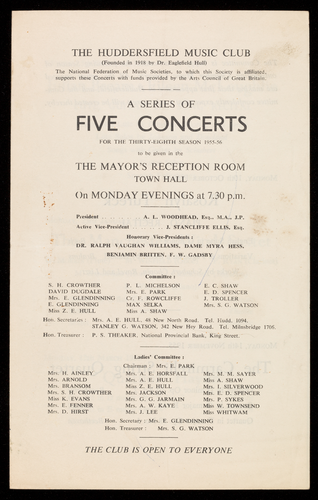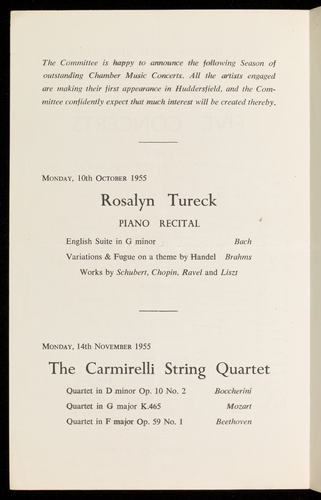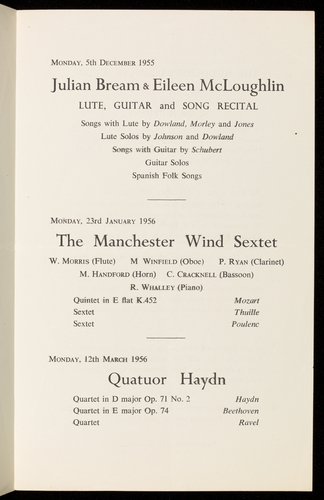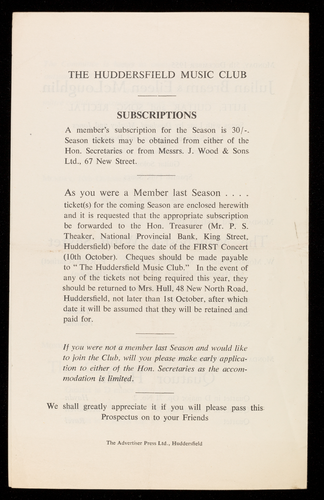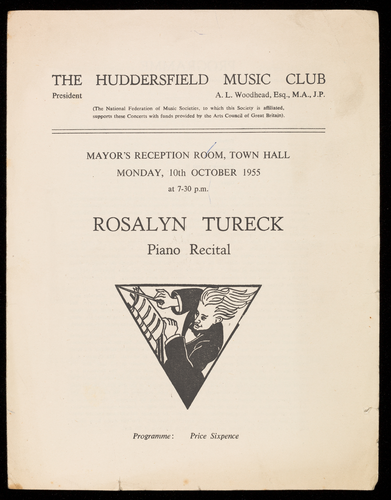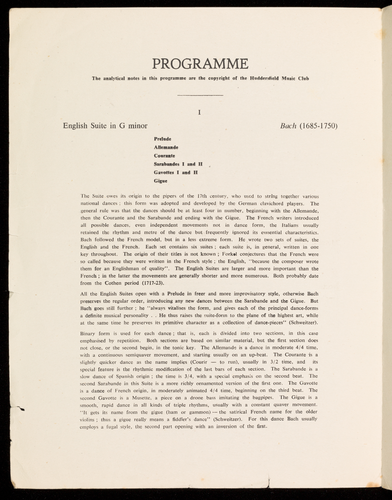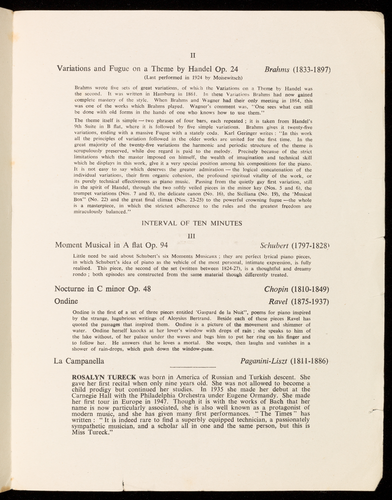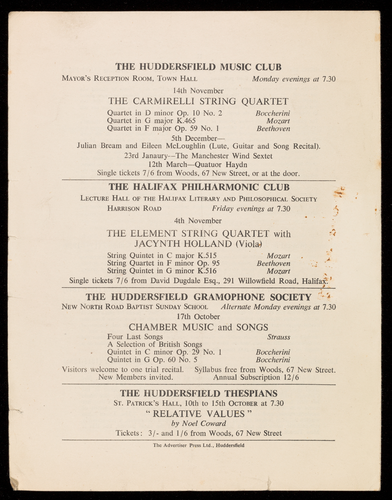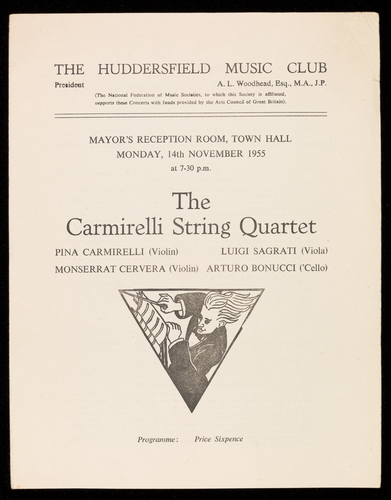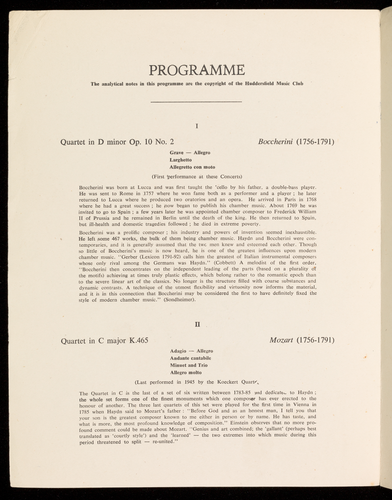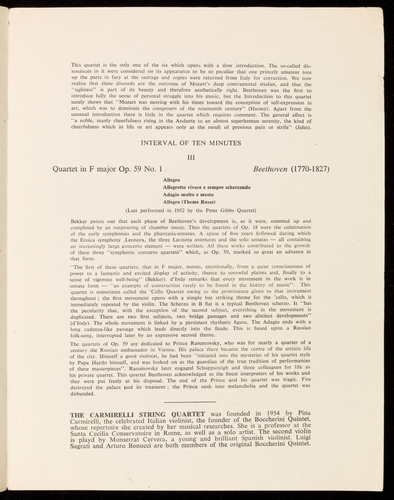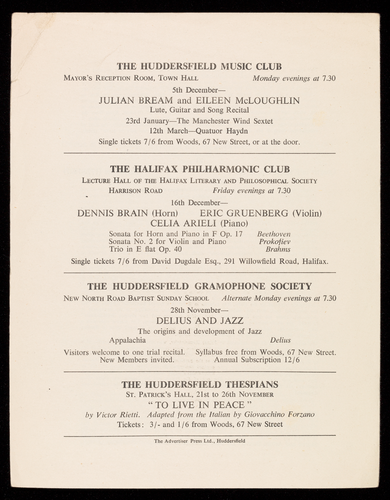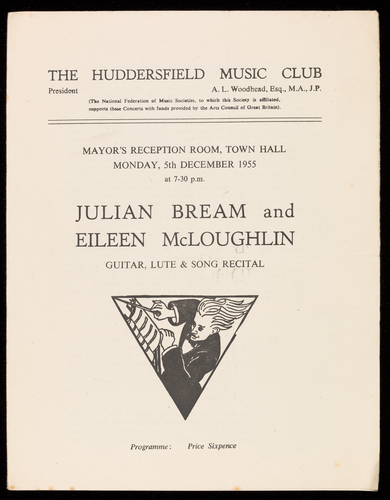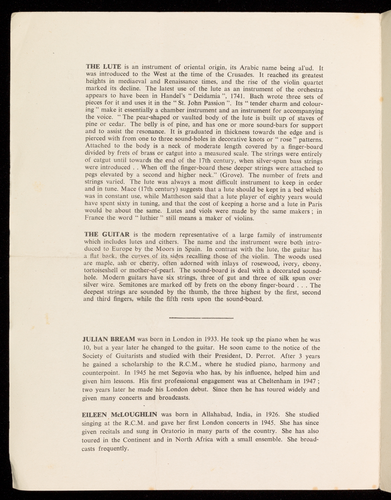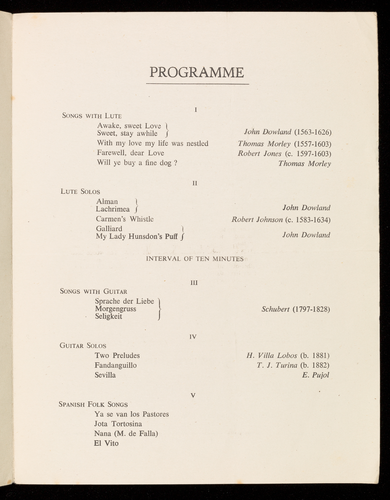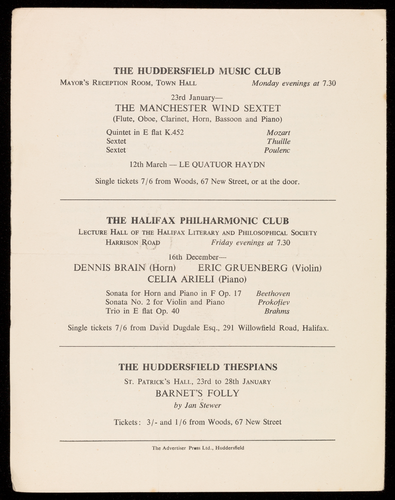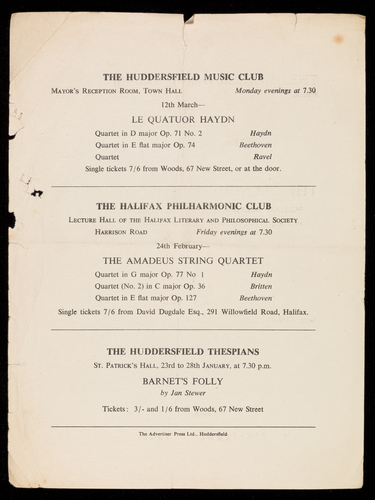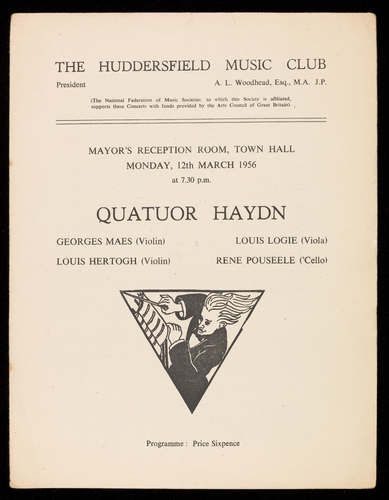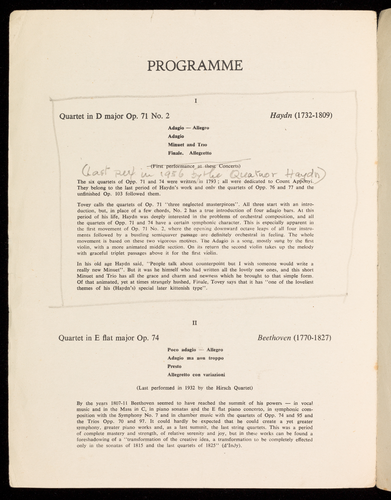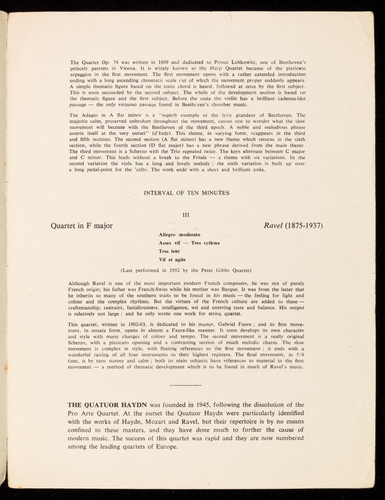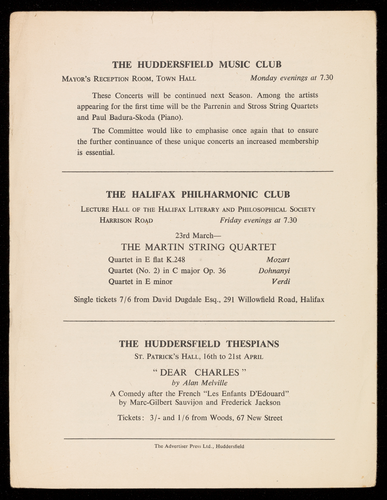Ocr'd Text:
ܐܝ ܗܕܝܬ
THE HUDDERSFIELD MUSIC CLUB
(Founded in 1918 by Dr. Eaglefield Hull)
The National Federation of Music Societies, to which this Society is affiliated,
supports these Concerts with funds provided by the Arts Council of Great Britain.
Aistr
A SERIES OF mobilnos
FIVE CONCERTS
FOR THE THIRTY-EIGHTH SEASON 1955-56
to be given in the
THE MAYOR'S RECEPTION ROOM
TOWN HALL OTO
On MONDAY EVENINGS at 7.30 p.m.
President
Active Vice-President
Honorary Vice-Presidents :
DR. RALPH VAUGHAN WILLIAMS, DAME MYRA HESS,
BENJAMIN BRITTEN, F. W. GADSBY
S. H. CROWTHER
DAVID DUGDALE
Mrs. E. GLENDINNING
E. GLENDINNING
Miss Z. E. HULL
A. L. WOODHEAD, Esq., M.A., J.P.
J. STANCLIFFE ELLIS, Esq.
Committee :
P. L. MICHELSON
Mrs. E. PARK
Cr. F. ROWCLIFFE
MAX SELKA
Miss A. SHAW
Hon. Secretaries : Mrs. A. E. HULL, 48 New North Road. Tel. Hudd. 1094.
Mrs. H. AINLEY
Mrs. ARNOLD
Mrs. BRANSOM
Mrs. S. H. CROWTHER
Miss K. EVANS
Mrs. E. FENNER
Mrs. D. HIRST
STANLEY G. WATSON, 342 New Hey Road. Tel. Milnsbridge 1706.
E. C. SHAW
E. D. SPENCER
J. TROLLER
Mrs. S. G. WATSON
Hon. Treasurer: P. S. THEAKER, National Provincial Bank, King Street.
21
Ladies' Committee:
Chairman : Mrs. E. PARK
Mrs. A. E. HORSFALL
Mrs. A. E. HULL
Miss Z. E. HULL
Mrs. JACKSON
Mrs. G. G. JARMAIN
Mrs. A. W. KAYE
Mrs. J. LEE
ATC
DarT
Mrs. M. M. SAYER
Miss A. SHAW
Mrs. I. SILVERWOOD
Mrs. E. D. SPENCER
Mrs. P. SYKES
Miss W. TOWNSEND
Miss WHITWAM
Hon. Secretary: Mrs. E. GLENDINNING
Hon. Treasurer: Mrs. S. G. WATSON
THE CLUB IS OPEN TO EVERYONE
Ocr'd Text:
The Committee is happy to announce the following Season of
outstanding Chamber Music Concerts. All the artists engaged
are making their first appearance in Huddersfield, and the Com-
mittee confidently expect that much interest will be created thereby.
MONDAY, 10th OCTOBER 1955
Rosalyn Tureck
PIANO RECITAL
English Suite in G minor
Variations & Fugue on a theme by Handel Brahms
Works by Schubert, Chopin, Ravel and Liszt
Bach
MONDAY, 14th NOVEMBER 1955
The Carmirelli String Quartet
Quartet in D minor Op. 10 No. 2
Quartet in G major K.465
Quartet in F major Op. 59 No. 1
Boccherini
Mozart
Beethoven
Ocr'd Text:
MONDAY, 5th DECEMBER 1955
Julian Bream & Eileen McLoughlin
LUTE, GUITAR and SONG RECITAL
Songs with Lute by Dowland, Morley and Jones
Lute Solos by Johnson and Dowland
Songs with Guitar by Schubert
Guitar Solos
Spanish Folk Songs
MONDAY, 23rd JANUARY 1956
The Manchester Wind Sextet
W. MORRIS (Flute) M WINFIELD (Oboe) P. RYAN (Clarinet)
M. HANDFORD (Horn) C. CRACKNELL (Bassoon)
R. WHALLEY (Piano)
Quintet in E flat K.452
Sextet
Sextet
MONDAY, 12th MARCH 1956
Quatuor Haydn
Quartet in D major Op. 71 No. 2
Quartet in E major Op. 74
Quartet
Mozart
Thuille
Poulenc
Haydn
Beethoven
Ravel
Ocr'd Text:
Boud die
THE HUDDERSFIELD MUSIC CLUB
nildquo loM nosl
IM
2201
13
cassia asilul
SUBSCRIPTIONS
A member's subscription for the Season is 30/-.
Season tickets may be obtained from either of the
Hon. Secretaries or from Messrs. J. Wood & Sons.
Ltd., 67 New Street.
As you were a Member last Season
ticket(s) for the coming Season are enclosed herewith
and it is requested that the appropriate subscription.
be forwarded to the Hon. Treasurer (Mr. P. S.
Theaker, National Provincial Bank, King Street,
Huddersfield) before the date of the FIRST Concert
IT
(dont (10th October). Cheques should be made payable
to
"The Huddersfield Music Club." In the event of
any of the tickets not being required this year, they
should be returned to Mrs. Hull, 48 New North Road,
Huddersfield, not later than 1st October, after which
date it will be assumed that they will be retained and
paid for.
If you were not a member last Season and would like
to join the Club, will you please make early applica-ACHOM
tion to either of the Hon. Secretaries as the accom-
modation is limited.
TOUJBU
We shall greatly appreciate it if you will please pass this
Prospectus on to your Friends
The Advertiser Press Ltd., Huddersfield
Ocr'd Text:
THE HUDDERSFIELD MUSIC
President
CLUB
A. L. Woodhead, Esq., M.A., J.P.
(The National Federation of Music Societies, to which this Society is affiliated,
supports these Concerts with funds provided by the Arts Council of Great Britain).
MAYOR'S RECEPTION ROOM, TOWN HALL
MONDAY, 10th OCTOBER 1955
at 7-30 p.m.
ROSALYN TURECK
Piano Recital
Programme:
Price Sixpence
Ocr'd Text:
PROGRAMME
The analytical notes in this programme are the copyright of the Huddersfield Music Club
English Suite in G minor
I
Prelude
Allemande
Courante
Sarabandes I and II
Gavottes I and II
Gigue
Bach (1685-1750)
The Suite owes its origin to the pipers of the 17th century, who used to string together various
national dances; this form was adopted and developed by the German clavichord players. The
general rule was that the dances should be at least four in number, beginning with the Allemande,
then the Courante and the Sarabande and ending with the Gigue. The French writers introduced
all possible dances,
dances, even independent movements not in dance form, the Italians usually
retained the rhythm and metre of the dance but frequently ignored its esssential characteristics.
Bach followed the French model, but in a less extreme form. He wrote two sets of suites, the
English and the French. Each set contains six suites; each suite is, in general, written in one
key throughout. The origin of their titles is not known; Forkel conjectures that the French were
so called because they were written in the French style; the English, "because the composer wrote
them for an Englishman of quality". The English Suites are larger and more important than the
French; in the latter the movements are generally shorter and more numerous. Both probably date
from the Cothen period (1717-23).
All the English Suites open with a Prelude in freer and more improvisatory style, otherwise Bach
preserves the regular order, introducing any new dances between the Sarabande and the Gigue. But
Bach goes still further; he "always vitalises the form, and gives each of the principal dance-forms
a definite musical personality. . He thus raises the suite-forin to the plane of the highest art, while
at the same time he preserves its primitive character as a collection of dance-pieces" (Schweitzer).
Binary form is used for each dance; that is, each is divided into two sections, in this case
emphasised by repetition. Both sections are based on similar material, but the first section does
not close, or the second begin, in the tonic key. The Allemande is a dance in moderate 4/4 time,
with a continuous semiquaver movement, and starting usually on an up-beat. The Courante is a
slightly quicker dance as the name implies (Courir
its
to run), usually in 3/2 time, and
special feature is the rhythmic modification of the last bars of each section. The Sarabande is a
slow dance of Spanish origin; the time is 3/4, with a special emphasis on the second beat. The
second Sarabande in this Suite is a more richly ornamented version of the first one. The Gavotte
is a dance of French origin, in moderately animated 4/4 time, beginning on the third beat. The
second Gavotte is a Musette, a piece on a drone bass imitating the bagpipes. The Gigue is a
smooth, rapid dance in all kinds of triple rhythms, usually with a constant quaver movement.
"It gets its name from the gigue (ham or gammon) - the satirical French name for the older
violins; thus a gigue really means a fiddler's dance" (Schweitzer). For this dance Bach usually
employs a fugal style, the second part opening with an inversion of the first.
-
Ocr'd Text:
II
Variations and Fugue on a Theme by Handel Op. 24
(Last performed in 1924 by Moisewitsch)
Brahms wrote five sets of great variations, of which the Variations on a Theme by Handel was
the second. It was written in Hamburg in 1861. In these Variations Brahms had now gained
complete mastery of the style. When Brahms and Wagner had their only meeting in 1864, this
was one of the works which Brahms played. Wagner's comment was, "One sees what can still
be done with old forms in the hands of one who knows how to use them."
The theme itself is simple two phrases of four bars, each repeated; it is taken from Handel's
9th Suite in B flat, where it is followed by five simple variations. Brahms gives it twenty-five
variations, ending with a massive Fugue with a stately coda. Karl Geringer writes: "In this work
all the principles of variation followed in the older works are united for the first time. In the
great majority of the twenty-five variations the harmonic and periodic structure of the theme is
scrupulously preserved, while due regard is paid to the melody. Precisely because of the strict
limitations which the master imposed on himself, the wealth of imagination and technical skill
which he displays in this work, glve it a very speciai position among his compositions for the piano.
It is not easy to say which deserves the greater admiration the logical concatenation of the
individual variations, their firm organic cohesion, the profound spiritual vitality of the work, or
its purely technical effectiveness as piano music. Passing from the quietly gay first variation, still
in the spirit of Handel, through the two softly veiled pieces in the minor key (Nos. 5 and 6), the
trumpet variations (Nos. 7 and 8), the delicate canon (No. 16), the Siciliana (No. 19), the 'Musical
Box" (No. 22) and the great final climax (Nos. 23-25) to the powerful crowning fugue -the whole
is a masterpiece, in which the strictest adherence to the rules and the greatest freedom are
miraculously balanced."
INTERVAL OF TEN MINUTES
Nocturne in C minor Op. 48
Ondine
Brahms (1833-1897)
-
III
Moment Musical in A flat Op. 94
Schubert (1797-1828)
Little need be said about Schubert's six Moments Musicaux; they are perfect lyrical piano pieces,
in which Schubert's idea of piano as the vehicle of the most personal, intimate expression, is fully
realised. This piece, the second of the set (written between 1824-27), is a thoughtful and dreamy
rondo; both episodes are constructed from the same material though differently treated.
Chopin (1810-1849)
Ravel (1875-1937)
Ondine is the first of a set of three pieces entitled 'Gaspard de la Nuit", poems for piano inspired
by the strange, lugubrious writings of Aloysius Bertrand. Beside each of these pieces Ravel has
quoted the passages that inspired them. Ondine is a picture of the movement and shimmer of
water. Ondine herself knocks at her lover's window with drops of rain; she speaks to him of
the lake without, of her palace under the waves and begs him to put her ring on his finger and
to follow her. He answers that he loves a mortal. She weeps, then laughs and vanishes in a
shower of rain-drops, which gush down the window-pane.
La Campanella
Paganini-Liszt (1811-1886)
ROSALYN TURECK was born in America of Russian and Turkish descent. She
gave her first recital when only nine years old. She was not allowed to become a
child prodigy but continued her studies. In 1935 she made her debut at the
Carnegie Hall with the Philadelphia Orchestra under Eugene Ormandy. She made
her first tour in Europe in 1947. Though it is with the works of Bach that her
name is now particularly associated, she is also well known as a protagonist of
modern music, and she has given many first performances.
performances. "The Times has
written: "It is indeed rare to find a superbly equipped technician, a passionately
sympathetic musician, and a scholar all in one and the same person, but this is
Miss Tureck."
Ocr'd Text:
THE HUDDERSFIELD MUSIC CLUB
MAYOR'S RECEPTION ROOM, TOWN HALL
14th November
THE CARMIRELLI STRING
Quartet in D minor Op. 10 No. 2
Quartet in G major K.465
Quartet in F major Op. 59 No. 1
5th December-
Monday evenings at 7.30
QUARTET
Boccherini
Mozart
Beethoven
Julian Bream and Eileen McLoughlin (Lute, Guitar and Song Recital).
23rd Janaury--The Manchester Wind Sextet
12th March-Quatuor Haydn
Single tickets 7/6 from Woods, 67 New Street, or at the door.
THE HALIFAX PHILHARMONIC CLUB
LECTURE HALL OF THE HALIFAX LITERARY AND PHILOSOPHICAL SOCIETY
HARRISON ROAD
Friday evenings at 7.30
4th November
THE ELEMENT STRING QUARTET with
JACYNTH HOLLAND (Viola)
String Quintet in C major K.515
String Quartet in F minor Op. 95
String Quintet in G minor K.516
Single tickets 7/6 from David Dugdale Esq., 291 Willowfield Road, Halifax.
Four Last Songs
A Selection of British Songs
Quintet in C minor Op. 29 No. 1
Quintet in G Op. 60 No. 5
Mozart
Beethoven
Mozart
THE HUDDERSFIELD GRAMOPHONE SOCIETY
NEW NORTH ROAD BAPTIST SUNDAY SCHOOL
Alternate Monday evenings at 7.30
17th October
CHAMBER MUSIC and SONGS
Strauss
Boccherini
Boccherini
Visitors welcome to one trial recital. Syllabus free from Woods, 67 New Street.
New Members invited.
Annual Subscription 12/6
THE HUDDERSFIELD THESPIANS
ST. PATRICK'S HALL, 10th to 15th OCTOBER at 7.30
RELATIVE VALUES"
by Noel Coward
Tickets 3/- and 1/6 from Woods, 67 New Street
The Advertiser Press Ltd., Huddersfield
Ocr'd Text:
THE HUDDERSFIELD MUSIC CLUB
President
A. L. Woodhead, Esq., M.A., J.P.
(The National Federation of Music Societies, to which this Society is affiliated,
supports these Concerts with funds provided by the Arts Council of Great Britain).
MAYOR'S RECEPTION ROOM, TOWN HALL
MONDAY, 14th NOVEMBER 1955
at 7-30 p.m.
The
Carmirelli String Quartet
PINA CARMIRELLI (Violin)
LUIGI SAGRATI (Viola)
MONSERRAT CERVERA (Violin) ARTURO BONUCCI ('Cello)
Programme: Price Sixpence
Ocr'd Text:
PROGRAMME
The analytical notes in this programme are the copyright of the Huddersfield Music Club
Quartet in D minor Op. 10 No. 2
I
Allegro
Quartet in C major K.465
Grave
Larghetto
Allegretto con moto
(First performance at these Concerts)
Boccherini was born at Lucca and was first taught the 'cello by his father. a double-bass player.
He was sent to Rome in 1757 where he won fame both as a performer and a player; he later
returned to Lucca where he produced two oratorios and an opera. He arrived in Paris in 1768
where he had a great success; he now began to publish his chamber music. About 1769 he was
invited to go to Spain; a few years later he was appointed chamber composer to Frederick William
II of Prussia and he remained in Berlin until the death of the king. He then returned to Spain,
but ill-health and domestic tragedies followed; he died in extreme poverty.
Boccherini was a prolific composer; his industry and powers of invention seemed inexhaustible.
He left some 467 works, the bulk of them being chamber music. Haydn and Beccherini were con-
temporaries, and it is generally assumed that the twc men knew and esteemed each other. Though
so little of Boccherini's music is now heard, he is one of the greatest influences upon modern
chamber music. "Gerber (Lexicon 1791-92) calls him the greatest of Italian instrumental composers
whose only rival among the Germans was Haydn." (Cobbett) A melodist of the first order,
"Boccherini then concentrates on the independent leading of the parts (based on a plurality of
the motifs) achieving at times truly plastic effects, which belong rather to the romantic epoch than
to the severe linear art of the classics. No longer is the structure filled with coarse substances and
dynamic contrasts. A technique of the utmost flexibility and virtuosity now informs the material,
and it is in this connection that Boccherini may be considered the first to have definitely fixed the
style of modern chamber music." (Sondheimer).
Boccherini (1756-1791)
II
-
Mozart (1756-1791)
Adagio Allegro
Andante cantabile
Minuet and Trio
Allegro molto
(Last performed in 1945 by the Koeckert Quart
The Quartet in C is the last of a set of six written between 1783-85 d dedicate to Haydn;
the whole set forms one of the finest monuments which one composer has ever erected to the
honour of another. The three last quartets of this set were played for the first time in Vienna in
1785 when Haydn said to Mozart's father: "Before God and as an honest man, I tell you that
your son is the greatest composer known to me either in person or by name. He has taste, and
what is more, the most profound knowledge of composition." Einstein observes that no more pro-
found comment could be made about Mozart. "Genius and art combined; the 'gallant' (perhaps best
translated as 'courtly style') and the 'learned' the two extremes into which music during this
period threatened to split re-united."
Ocr'd Text:
This quartet is the only one of the six which opens with a slow introduction. The so-called dis-
sonances in it were considered on its appearance to be so peculiar that one princely amateur tore
up the parts in fury at the outrage and copies were returned from Italy for correction. We now
realise that these discords are the outcome of Mozart's deep contrapuntal studies, and that the
"ugliness" is part of its beauty and therefore aesthetically right. Beethoven was the first to
introduce fully the sense of personal struggle into his music, but the Introduction to this quartet
surely shows that "Mozart was moving with his times toward the conception of self-expression in
art, which was to dominate the composers of the nineteenth century" (Hussey). Apart from the
unusual introduction there is little in the quartet which requires comment. The general effect is
"a noble, manly cheerfulness rising in the Andante to an almost superhuman serenity, the kind of
cheerfulness which in life or art appears only as the result of previous pain or strife" (Jahn).
INTERVAL OF TEN MINUTES
Quartet in F major Op. 59 No. 1
III
Beethoven (1770-1827)
Allegro
Allegretto vivace e sempre scherzando
Adagio molto e mesto
Allegro (Theme Russe)
(Last performed in 1952 by the Peter Gibbs Quartet)
Bekker points out that each phase of Beethoven's development is, as it were, summed up and
completed by an outpouring of chamber music. Thus the quartets of Op. 18 were the culmination
of the early symphonies and the phantasia-sonatas. A space of five years followed during which
the Eroica symphony ,Leonora, the three Lecnora overtures and the solo sonatas - all containing
an increasingly large concerto element - were written. All these works contributed to the growth
of these three "symphonic concerto quartets" which, as Op. 59, marked so great an advance in
that form.
"The first of these quartets, that in F major, moves, emotionally, from a quiet consciousness of
power to a fantastic and excited display of activity, thence to sorowful plaints and, finally to a
sense of vigorous well-being" (Bekker). d'Indy remarks that every movement in the work is in
sonata form "an example of construction rarely to be found in the history of music". This
quartet is sometimes called the 'Cello Quartet owing to the prominence given to that instrument
throughout; the first movement opens with a simple but striking theme for the 'cello, which is
immediately repeated by the violin. The Scherzo in B flat is a typical Beethoven scherzo. It "has
the pecularity that, with the exception of the second subject, everything in the movement is
duplicated. There are two first subjects, two bridge passages and two distinct developments"
(d'Indy). The whole movement is linked by a persistant rhythmic figure. The Adagio ends with a
long cadenza-like passage which leads directly into the finale. This is based upon a Russian
folk-song, interrupted later by an expressive second theme.
The quartets of Op. 59 are dedicated to Prince Rasumovsky, who was for nearly a quarter of a
century the Russian ambassador in Vienna. His palace there became the centre of the artistic life
of the city. Himself a good violinist, he had been initiated into the mysteries of his quartet style
by Papa Haydn himself, and was looked on as the guardian of the true tradition of performances
of these masterpieces". Rasumovsky later engaged Schuppanzigh and three colleagues for life as
his private quartet. This quartet Beethoven acknowledged as the finest interpreters of his works and
they were put freely at his disposal. The end of the Prince and his quartet was tragic. Fire
destroyed the palace and its treasures; the Prince sank into melancholia and the quartet was
disbanded.
THE CARMIRELLI STRING QUARTET was founded in 1954 by Pina
Carmirelli, the celebrated Italian violinist, the founder of the Boccherini Quintet,
whose repertoire she created by her musical researches. She is a professor at the
Santa Cecilia Conservatoire in Rome, as well as a solo artist. The second violin
is playd by Monserrat Cervera, a young and brilliant Spanish violinist. Luigi
Sagrati and Arturo Bonucci are both members of the original Boccherini Quintet.
Ocr'd Text:
THE HUDDERSFIELD MUSIC CLUB
MAYOR'S RECEPTION ROOM, TOWN HALL
5th December-
JULIAN BREAM and EILEEN MCLOUGHLIN
Lute, Guitar and Song Recital
23rd January-The Manchester Wind Sextet
12th March-Quatuor Haydn
Single tickets 7/6 from Woods, 67 New Street, or at the door.
THE HALIFAX PHILHARMONIC CLUB
LECTURE HALL OF THE HALIFAX LITERARY AND PHILOSOPHICAL SOCIETY
HARRISON ROAD
Friday evenings at 7.30
16th December-
DENNIS BRAIN (Horn)
Monday evenings at 7.30
CELIA ARIELI (Piano)
ERIC GRUENBERG (Violin)
Sonata for Horn and Piano in F Op. 17
Sonata No. 2 for Violin and Piano
Trio in E flat Op. 40
Single tickets 7/6 from David Dugdale Esq., 291 Willowfield Road, Halifax.
Appalachia
Visitors welcome to one trial recital.
New Members invited.
THE HUDDERSFIELD GRAMOPHONE SOCIETY
NEW NORTH ROAD BAPTIST SUNDAY SCHOOL Alternate Monday evenings at 7.30
Beethoven
Prokofiev
Brahms
28th November-
DELIUS AND JAZZ
The origins and development of Jazz
Delius
Syllabus free from Woods, 67 New Street.
Annual Subscription 12/6
The Advertiser Press Ltd., Huddersfield
THE HUDDERSFIELD THESPIANS
ST. PATRICK'S HALL, 21st to 26th NOVEMBER
TO LIVE IN PEACE"
by Victor Rietti. Adapted from the Italian by Giovacchino Forzano
Tickets: 3/- and 1/6 from Woods, 67 New Street
Ocr'd Text:
CLUB
A. L. Woodhead, Esq., M.A., J.P.
THE HUDDERSFIELD MUSIC
MUSIC
President
(The National Federation of Music Societies, to which this Society is affiliated,
supports those Concerts with funds provided by the Arts Council of Great Britain).
MAYOR'S RECEPTION ROOM, TOWN HALL
MONDAY, 5th DECEMBER 1955
at 7-30 p.m.
JULIAN BREAM and
EILEEN MCLOUGHLIN
GUITAR, LUTE & SONG RECITAL
Programme: Price Sixpence
Ocr'd Text:
THE LUTE is an instrument of oriental origin, its Arabic name being al'ud. It
was introduced to the West at the time of the Crusades. It reached its greatest
heights in mediaeval and Renaissance times, and the rise of the violin quartet
marked its decline. The latest use of the lute as an instrument of the orchestra
appears to have been in Handel's "Deidamia ", 1741. Bach wrote three sets of
pieces for it and uses it in the "St. John Passion ". Its "tender charm and colour-
ing" make it essentially a chamber instrument and an instrument for accompanying
the voice. The pear-shaped or vaulted body of the lute is built up of staves of
pine or cedar. The belly is of pine, and has one or more sound-bars for support
and to assist the resonance. It is graduated in thickness towards the edge and is
pierced with from one to three sound-holes in decorative knots or "rose" patterns.
Attached to the body is a neck of moderate length covered by a finger-board
divided by frets of brass or catgut into a measured scale. The strings were entirely
of catgut until towards the end of the 17th century, when silver-spun bass strings
were introduced . . When off the finger-board these deeper strings were attached to
pegs elevated by a second and higher neck." (Grove). The number of frets and
strings varied. The lute was always a most difficult instrument to keep in order
and in tune. Mace (17th century) suggests that a lute should be kept in a bed which
was in constant use, while Mattheson said that a lute player of eighty years would
have spent sixty in tuning, and that the cost of keeping a horse and a lute in Paris
would be about the same. Lutes and viols were made by the same makers; in
France the word "luthier" still means a maker of violins.
THE GUITAR is the modern representative of a large family of instruments
which includes lutes and cithers. The name and the instrument were both intro-
duced to Europe by the Moors in Spain. In contrast with the lute, the guitar has
a flat back, the curves of its sides recalling those of the violin. The woods used
are maple, ash or cherry, often adorned with inlays of rosewood, ivory, ebony,
tortoiseshell or mother-of-pearl. The sound-board is deal with a decorated sound-
hole. Modern guitars have six strings, three of gut and three of silk spun over
silver wire. Semitones are marked off by frets on the ebony finger-board... The
deepest strings are sounded by the thumb, the three highest by the first, second
and third fingers, while the fifth rests upon the sound-board.
JULIAN BREAM was born in London in 1933. He took up the piano when he was
10, but a year later he changed to the guitar. He soon came to the notice of the
Society of Guitarists and studied with their President, D. Perrot. After 3 years
he gained a scholarship to the R.C.M., where he studied piano, harmony and
counterpoint. In 1945 he met Segovia who has, by his influence, helped him and
given him lessons. His first professional engagement was at Cheltenham in 1947;
two years later he made his London debut. Since then he has toured widely and
given many concerts and broadcasts.
EILEEN MCLOUGHLIN was born in Allahabad, India, in 1926. She studied
singing at the R.C.M. and gave her first London concerts in 1945. She has since
given recitals and sung in Oratorio in many parts of the country. She has also
toured in the Continent and in North Africa with a small ensemble. She broad-
casts frequently.
Ocr'd Text:
SONGS WITH LUTE
LUTE SOLOS
Awake, sweet Love
Sweet, stay awhile f
With my love my life was nestled
Farewell, dear Love
Will ye buy a fine dog?
Alman
Lachrimea f
Carmen's Whistle
Galliard
1
My Lady Hunsdon's Puff
SONGS WITH GUITAR
PROGRAMME
GUITAR SOLOS
Sprache der Liebe
Morgengruss
Seligkeit
Two Preludes
Fandanguillo
Sevilla
SPANISH FOLK SONGS
I
Ya se van los Pastores
Jota Tortosina
Nana (M. de Falla)
El Vito
II
INTERVAL OF TEN MINUTES A
III
IV
L.
V
John Dowland (1563-1626)
Thomas Morley (1557-1603)
Robert Jones (c. 1597-1603)
Thomas Morley
John Dowland
Robert Johnson (c. 1583-1634)
John Dowland
Schubert (1797-1828)
H. Villa Lobos (b. 1881)
T. J. Turina (b. 1882)
E. Pujol
Ocr'd Text:
THE HUDDERSFIELD MUSIC CLUB
MAYOR'S RECEPTION ROOM, TOWN HALL
23rd January-
THE MANCHESTER WIND SEXTET
(Flute, Oboe, Clarinet, Horn, Bassoon and Piano)
Quintet in E flat K.452
Sextet
Sextet
12th March - LE QUATUOR HAYDN
Single tickets 7/6 from Woods, 67 New Street, or at the door.
16th December-
Monday evenings at 7.30
THE HALIFAX PHILHARMONIC CLUB
LECTURE HALL OF THE HALIFAX LITERARY AND PHILOSOPHICAL SOCIETY
Friday evenings at 7.30
HARRISON ROAD
DENNIS BRAIN (Horn)
Mozart
Thuille
Poulenc
CELIA ARIELI (Piano)
ERIC GRUENBERG (Violin)
Sonata for Horn and Piano in F Op. 17
Sonata No. 2 for Violin and Piano
Trio in E flat Op. 40
Single tickets 7/6 from David Dugdale Esq., 291 Willowfield Road, Halifax.
The Advertiser Press Ltd., Huddersfield
Beethoven
Prokofiev
Brahms
THE HUDDERSFIELD THESPIANS
ST. PATRICK'S HALL, 23rd to 28th JANUARY
BARNET'S FOLLY
by Jan Stewer
Tickets: 3/- and 1/6 from Woods, 67 New Street
Ocr'd Text:
THE HUDDERSFIELD MUSIC CLUB
President
A. L. Woodhead, Esq., M.A., J.P.
(The National Federation of Music Societies, to which this Society is affiliated,
supports these Concerts with funds provided by the Arts Council of Great Britain).
MAYOR'S RECEPTION ROOM, TOWN HALL
MONDAY, 23rd JANUARY 1956, 7.30 p.m.
THE MANCHESTER WIND SEXTET
WILLIAM MORRIS (Flute)
MICHAEL WINFIELD (Oboe)
PAT RYAN (Clarinet)
MAURICE HANDFORD (Horn)
CHARLES CRACKNELL (Bassoon)
RAYSON WHALLEY (Piano)
Sextet in B flat major Op. 6
Sextet (1932-39)
Quintet in E flat K.452
I
Allegro moderato
Larghetto
Gavotte
Finale Vivace
II
Finale Prestissimo
Allegro vivace
Divertissement Andantino
PROGRAMME
Ludwig Thuille (1861-1907)
INTERVAL OF TEN MINUTES
III
Largo. Allegro moderato
Larghetto
Rondo
Francis Poulenc (b. 1899)
Mozart (1756-1791)
THREE PENCE
Ocr'd Text:
THE HUDDERSFIELD MUSIC CLUB
MAYOR'S RECEPTION ROOM, TOWN HALL
12th March-
LE QUATUOR HAYDN
Quartet in D major Op. 71 No. 2
Quartet in E flat major Op. 74
Quartet
Monday evenings at 7.30
Haydn
Beethoven
Ravel
Single tickets 7/6 from Woods, 67 New Street, or at the door.
THE HALIFAX PHILHARMONIC CLUB
LECTURE HALL OF THE HALIFAX LITERARY AND PHILOSOPHICAL SOCIETY
HARRISON ROAD
Friday evenings at 7.30
24th February-
THE AMADEUS STRING QUARTET
Quartet in G major Op. 77 No 1
Quartet (No. 2) in C major Op. 36
Quartet in E flat major Op. 127
Single tickets 7/6 from David Dugdale Esq., 291 Willowfield Road, Halifax.
The Advertiser Press Ltd., Huddersfield
Haydn
Britten
Beethoven
THE HUDDERSFIELD THESPIANS
ST. PATRICK'S HALL, 23rd to 28th JANUARY, at 7.30 p.m.
BARNET'S FOLLY
by Jan Stewer
Tickets: 3/- and 1/6 from Woods, 67 New Street
Ocr'd Text:
THE HUDDERSFIELD MUSIC CLUB
A. L. Woodhead, Esq., M.A. J.P.
President
(The National Federation of Music Societies to which this Society is affiliated,
supports these Concerts with funds provided by the Arts Council of Great Britain).
MAYOR'S RECEPTION ROOM, TOWN HALL
MONDAY, 12th MARCH 1956
at 7.30 p.m.
QUATUOR HAYDN
GEORGES MAES (Violin)
LOUIS HERTOGH (Violin)
1
LOUIS LOGIE (Viola)
RENE POUSEELE ('Cello)
Programme Price Sixpence
Ocr'd Text:
PROGRAMME
Quartet in D major Op. 71 No. 2
I
Adagio
Adagio
Minuet and Trio
Finale. Allegretto
exis
Quartet in E flat major Op. 74
Allegro
-(First performance at these Concerts)
Cast perf by the. Quatuor Haydn)
in 1956.
The six quartets of Opp. 71 and 74 were written in 1793; all were dedicated to Count Apponyi.
They belong to the last period of Haydn's work and only the quartets of Opp. 76 and 77 and the
unfinished Op. 103 followed them.
Tovey calls the quartets of Op. 71 "three neglected masterpieces". All three start with an intro-
duction, but, in place of a few chords, No. 2 has a true introduction of four adagio bars. At this
period of his life, Haydn was deeply interested in the problems of orchestral composition, and all
the quartets of Opp. 71 and 74 have a certain symphonic character. This is especially apparent in
the first movement of Op. 71 No. 2, where the opening downward octave leaps of all four instru-
ments followed by a bustling semiquaver passage are definitely orchestral in feeling. The whole
movement is based on these two vigorous motives. The Adagio is a song, mostly sung by the first
violin, with a more animated middle section. On its return the second violin takes up the melody
with graceful triplet passages above it for the first violin.
In his old age Haydn said, "People talk about counterpoint but I wish someone would write a
really new Minuet". But it was he himself who had written all the lovely new ones, and this short
Minuet and Trio has all the grace and charm and newness which he brought to that simple form.
Of that animated, yet at times strangely hushed, Finale, Tovey says that it has one of the loveliest
themes of his (Haydn's) special later kittenish type".
66
Haydn (1732-1809)
II
Poco adagio Allegro
Adagio ma non troppo
Presto
Allegretto con variazioni
(Last performed in 1932 by the Hirsch Quartet)
Beethoven (1770-1827)
By the years 1807-11 Beethoven seemed to have reached the summit of his powers in voca!
music and in the Mass in C, in piano sonatas and the E flat piano concerto, in symphonic com-
position with the Symphony No. 7 and in chamber music with the quartets of Opp. 74 and 95 and
the Trios Opp. 70 and 97. It could hardly be expected that he could create a yet greater
symphony, greater piano works and, as a last suminit, the last string quartets. This was a period
of complete mastery and strength, of relative serenity and joy, but in these works can be found a
foreshadowing of a "transformation of the creative idea, a transformation to be completely effected
only in the sonatas of 1815 and the last quartets of 1825" (d'Indy).
D
Ocr'd Text:
The Quartet Op. 74 was written in 1809 and dedicated to Prince Lobkowitz, one of Beethoven's
princely patrons in Vienna. It is widely known as the Harp Quartet because of the pizzicato
arpeggios in the first movement. The first movement opens with a rather extended introduction
ending with a long ascending chromatic scale cut of which the movement proper suddenly appears.
A simple thematic figure based on the tonic chord is heard, followed at once by the first subject.
This is soon succeeded by the second subject. The whole of the development section is based on
the thematic figure and the first subject. Before the coda the violin has a brilliant cadenza-like
passage the only virtuoso passage found in Beethoven's chamber music.
A
The Adagio in A flat minor is a "superb example of the lyric grandeur of Beethoven. The
majestic calm, preserved unbroken throughout the movement, causes one to wonder what the slow
movement will become with the Beethoven of the third epoch. A noble and melodious phrase
asserts itself at the very outset" (d'Indy). This theme, in varying form, reappears in the third
and fifth sections. The second section (A flat minor) has a new theme which returns in the sixth
section, while the fourth section (D flat major) has a new phrase derived from the main theme.
The third movement is a Scherzo with the Trio repeated twice. The keys alternate between C major
and C minor. This leads without a break to the Finale - a theme with six variations. In the
second variation the viola has a long and lovely melody; the sixth variation is built up over
a long pedal-point for the 'cello. The work ends with a short and brilliant coda.
Quartet in F major
INTERVAL OF TEN MINUTES
III
Allegro moderato
Assez vif Tres rythme
Tres lent
Vif et agite
(Last performed in 1952 by the Peter Gibbs Quartet)
Ravel (1875-1937)
Although Ravel is one of the most important modern French composers, he was not of purely
French origin; his father was French-Swiss while his mother was Basque. It was from the latter that
he inherits so many of the southern traits to be found in his music the feeling for light and
colour and the complex rhythms. But the virtues of the French culture are added to these -
craftsmanship, restraint, fastidiousness, intelligence, wit and unerring taste and balance. His output
is relatively not large; and he only wrote one work for string quartet.
60
This quartet, written in 1902-03, is dedicated to his master, Gabriel Faure, and its first move-
ment, in sonata form, opens in almost a Faure-like manner. It soon develops its own character
and style with many changes of colour and tempo. The second movement is a really original
Scherzo, with a pizzicato opening and a contrasting section of much melodic charm. The slow
movement is complex in style, with fleeting references to the first movement; it ends with a
wonderful raising of all four instruments to their highest registers. The final movement, in 5/8
time, is by turn stormy and calm; both its main subjects have references to material in the first
movement - a method of thematic development which is to be found in much of Ravel's music.
THE QUATUOR HAYDN was founded in 1945, following the dissolution of the
Pro Arte Quartet. At the outset the Quatuor Haydn were particularly identified
with the works of Haydn, Mozart and Ravel, but their repertoire is by no means
confined to these masters, and they have done much to further the cause of
modern music. The success of this quartet was rapid and they are now numbered
among the leading quartets of Europe.
Ocr'd Text:
THE HUDDERSFIELD MUSIC CLUB
MAYOR'S RECEPTION ROOM, TOWN HALL
These Concerts will be continued next Season. Among the artists
appearing for the first time will be the Parrenin and Stross String Quartets
and Paul Badura-Skoda (Piano).
The Committee would like to emphasise once again that to ensure
the further continuance of these unique concerts an increased membership
is essential.
Monday evenings at 7.30
THE HALIFAX PHILHARMONIC CLUB
LECTURE HALL OF THE HALIFAX LITERARY AND PHILOSOPHICAL SOCIETY
HARRISON ROAD
Friday evenings at 7.30
23rd March-
THE MARTIN STRING QUARTET
-
Quartet in E flat K.248
Quartet (No. 2) in C major Op. 36
Quartet in E minor
Mozart
Dohnanyi
Verdi
Single tickets 7/6 from David Dugdale Esq., 291 Willowfield Road, Halifax
THE HUDDERSFIELD THESPIANS
ST. PATRICK'S HALL, 16th to 21st APRIL
The Advertiser Press Ltd., Huddersfield
"DEAR CHARLES "
by Alan Melville
A Comedy after the French "Les Enfants D'Edouard".
by Marc-Gilbert Sauvijon and Frederick Jackson
Tickets 3/- and 1/6 from Woods, 67 New Street




























 loading...
loading...